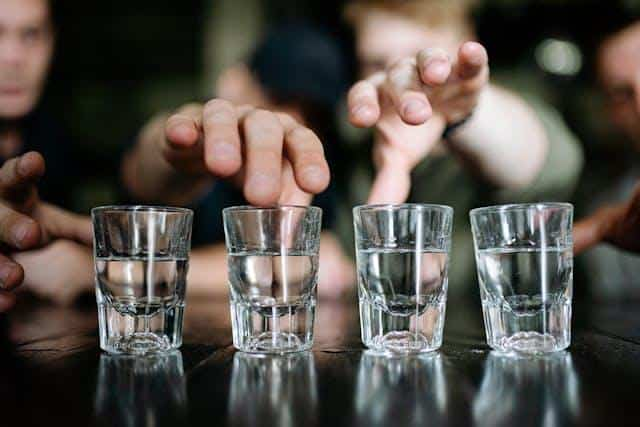Join our live online group lessons starting September 1! Sign up until August 22 here.
Days
Hours
Minutes
Join our live online group lessons starting September 1! Sign up until August 22 here.

Picture this — it’s Friday night, and after a long week, you finally find yourself in a kafana, surrounded by good company. The waiter sets down a tray of shot glasses filled with a clear, innocent-looking liquid. You raise your glass, clink it with a Živeli!, and down the shot — only to be hit with a fiery rush that warms you from the inside out. That, my friend, is Serbian rakija. More than a drink — it’s an elixir that melts away stress and turns even the shyest folks into the life of the party.
Also, this magic liquid is a cornerstone of Serbian culture, tradition, and hospitality. So, if you want to drink rakija like a local, or you’re just curious, here’s all you need to know about the most popular beverage from the Balkans.
First things first — what is rakija? For those who never had a chance to pour one (or ten) down their throat, rakija is a fruit brandy popular across the Balkans. Another thing worth mentioning: it’s not for the faint-hearted.
The thing is, rakija packs a punch — big time. While the alcohol content varies, it typically floats around 50%. Plus, you drink it straight — no ice or other beverages to dilute it.
Rakija also boasts a powerful flavor and a distinct scent. Because of all that, this drink is rarely a love at first sip. Instead, it’s an acquired taste, so if you hate it from the get-go, give it another chance — you might love it in the end.
One of our earlier posts explains why coffee plays a key role in Serbian social culture. Well, rakija is no different. It’s a phenomenal social lubricant able to turn the most awkward situations into a full-on party. No wonder it’s a staple at every kafana and big celebrations like slava, Christmas, and weddings.
So, if you’re not exactly a social butterfly, a shot of rakija can help you loosen up and go with the flow.
But rakija isn’t just about partying — it’s a symbol of Serbian hospitality. Walk into a Serbian home, especially in the countryside, and chances are you’ll be greeted with a glass of domaća rakija (homemade rakija) and a host who won’t rest until you’ve had at least one sip… or three.
And don’t be surprised if you leave with a bottle — because in Serbia, a proper rakija stash is a must for guests and good times alike!

Did we mention that rakija is basically a cure-all in Serbian households? Sore throat? Soak a cloth in rakija and wrap it around your neck. Fever? A good rakija rubdown is the go-to remedy. Pesky mosquito bite? A drop of the good old rakija will do the trick.
Some even swear by it as an immune booster. Therefore, they start the day not with a smoothie but with a shot of rakija — na prazan stomak (on an empty stomach). Do we recommend this? Not exactly — but hey, it’s a tradition worth knowing about!
Things are never dull with rakija. After all, it comes in all sorts of flavors and strengths. The process is simple, though: fruits are boiled and distilled in a special cauldron called kazan, resulting in the liquid fire we all know and (eventually) love. Here are some of the most popular types:
As Serbia’s national drink, rakija makes for a perfect souvenir — whether you’re treating friends and family back home or indulging yourself. As we mentioned, you’ll find it in almost every shop and supermarket, with price often reflecting quality.
But if you want the real deal, nothing beats homemade rakija straight from the source. Just ask around, and you’ll quickly find plenty of locals who take pride in crafting their own liquid gold.
Of course, if you’d rather skip the search, online stores like Rakija Market and Rakia Bar can bring Serbia’s favorite spirit straight to your doorstep.
Once you’ve picked your favorite brandy, it’s time to savor it. Here’s how to enjoy rakija like a local.
We always pour rakija in small shots. Serbs simply call it čašica (small cup).
Drinking alone? That’s rare in Serbia! Clink your čašica with friends and say Živeli! (Cheers!). And don’t forget — maintaining eye contact while toasting is a sign of respect, and Serbs take it seriously.
Forget the bottoms up approach. Rakija is way too strong for that. Take small sips, let the warmth spread, and enjoy the full experience — like a true rakija connoisseur!
If you happen to wake up with a classic mamurluk (hangover), don’t worry — Serbs have the ultimate cure: rasol. This salty, slightly pink liquid from a barrel of kiseli kupus (sauerkraut) might not win any awards for taste or smell, but it’s packed with electrolytes and other lifesavers. So, pinch your nose, take a deep breath, and down it — your head will thank you later!
As you can see, Serbian rakija isn’t just a drink — it’s an experience. It gets the party started, brings people together, and eases stress. Rumor has it that it even cures colds! In any case, it’s the perfect way to dive into the local flavor and culture. And if you’re learning Serbian, a little rakija might just loosen your tongue and help you speak confidently!
Much like rakija, the Serbian language is best enjoyed in good company. If you’re ready to take the plunge, join our group classes and sharpen your skills in a fun, relaxed setting. Živeli!